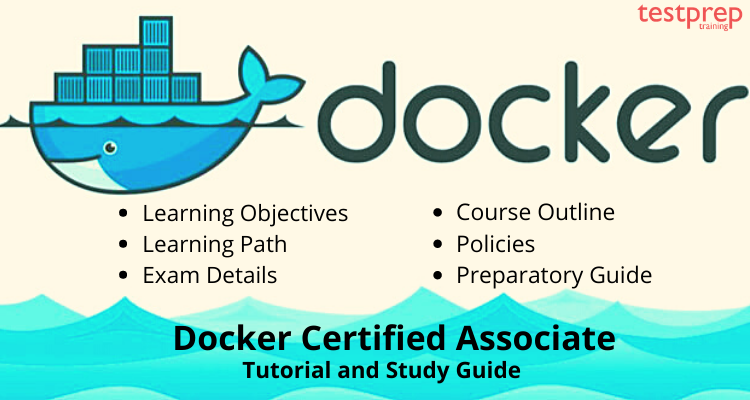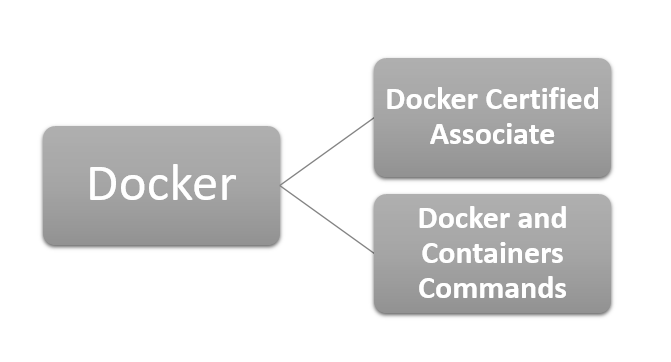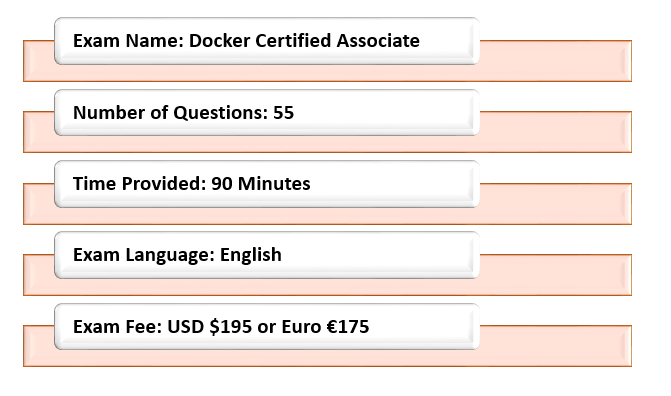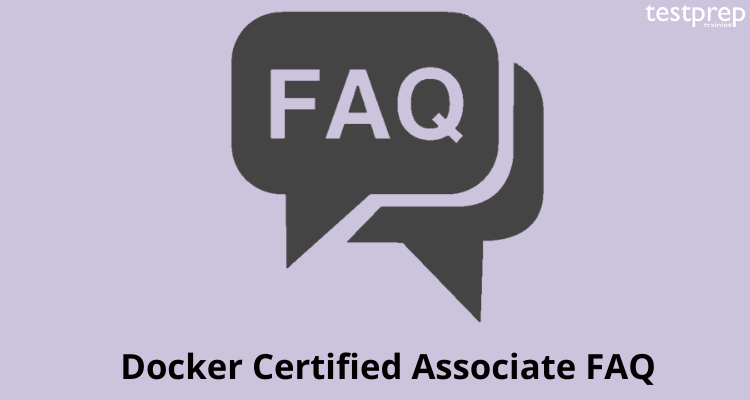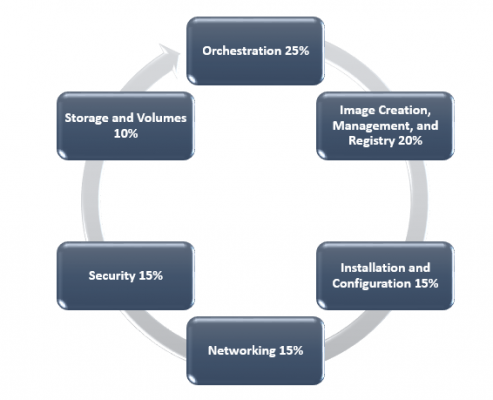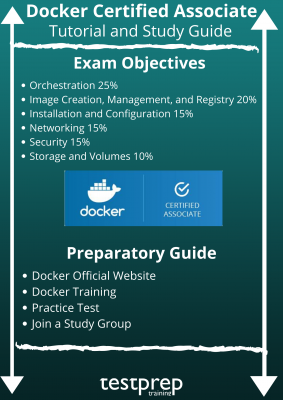Docker Certified Associate
Docker is an enterprise-ready container platform that enables organizations to seamlessly build, share, and run any application, anywhere. Docker facilities are highly sought after, and the Docker Certified Associate certification exam is designed to prove that skillset with real-world questions created by experienced Docker practitioners.
The skills and knowledge this exam measures are obtained from an understanding of the jobs of current Docker users. A team of highly qualified Docker experts defined the test content and developed the test items.
The job of a Docker Certified Associate
This exam is based upon critical job activities a Docker Certified Associate performs. The skills and knowledge certified by this exam represent a level of expertise where a certified Docker Associate can:
- Run containerized applications from pre-existing images collected in a centralized registry.
- Deploy images across the cluster.
- Triage and resolve issue reports from stakeholders and resolve.
- Standup up on Enterprise clusters with one UCP manager, one DTR replica, and one worker node.
- Migrate traditional applications to containers.
- Configure and troubleshoot Docker engine.
- Perform general maintenance and configuration.

Benefits of the Docker Certification
- Recognition for your Docker skills with an official Docker credential
- Digital certificate and use of the Docker Certified Associate logo
- Online verification of Docker Certified status by potential employers
- Exclusive access to the Docker Certified professional network on LinkedIn and invites to certified-only events
Learning Objectives
The candidate has to go through the learning objectives for the Docker Certified Associate exam if they are preparing for it. So, here are the learning objectives of the Docker Certified Associate:
- Orchestration 25%
- Image Creation, Management, and Registry 20%
- Installation and Configuration 15%
- Networking 15%
- Security 15%
- Storage and Volumes 10%
Learning Path
Docker Certifications validate technical knowledge with an industry-recognized credential. Our certifications recognize technical skills on the Docker platform. The Docker offers mainly two certifications i.e. Docker Certified Associate and Docker and Containers Commands.
Docker Certified Associate Exam Details
The Docker Certified Associate exam has 13 multiple choice and 42 discrete option multiple-choice questions which the candidate has to complete in 90 minutes. The exam is available in the English language. Also, the fee for the Docker Certified Associate exam is USD $195 or Euro €175. Further, the result will be delivered immediately.
The Docker Certified Associate exam format:
Docker Certified Associate Requirements
Candidates for this certification should have at least six months to one year of experience with Docker, including exposure to the Docker Enterprise Edition. The knowledge, skills and experience required at this level should also include:
- container security
- experience with at least one cloud provider
- configuration management tools
- Linux and/or Windows Server
Docker Certified Associate FAQ
Check: Docker Certified Associate Interview questions
Docker Certified Associate Exam Course Outline
Docker has divided the syllabus into various sections. The Docker Certified Associate exam includes its objectives and sub-topics in it. The Docker Certified Associate exam objectives are:
Domain 1: Orchestration (25% of exam)
- Complete the setup of a swarm mode cluster, with managers and worker nodes. (Documentation: Create a swarm)
- Describe and demonstrate how to extend the instructions to run individual containers into running services under the swarm. (Documentation: Deploy service to the swarm)
- Describe the importance of quorum in a swarm cluster.
- Describe the difference between running a container and running a service.
- Interpret the output of “docker inspects” commands. (Documentation: Inspect a service on the swarm)
- Convert an application deployment into a stack file using a YAML compose file with “docker stack deploy” (Documentation: docker stack deploy)
- Manipulate a running stack of services. (Documentation: Related commands)
- Describe and demonstrate orchestration activities.
- Increase the number of replicas. (Documentation: docker service scale)
- Add networks, publish ports. (Documentation: Networking overview)
- Mount volumes. (Documentation: Use volumes)
- Describe and demonstrate how to run replicated and global services. (Documentation: Replicated and global services)
- Apply node labels to demonstrate the placement of tasks. (Documentation: docker node update)
- Describe and demonstrate how to use templates with “docker service create”. (Documentation: Create services using templates)
- Identify the steps needed to troubleshoot a service not deploying. (Documentation: Deploy a service to the swarm)
- Describe how a Dockerized application communicates with legacy systems. (Documentation: Container networking)
- Describe how to deploy containerized workloads as Kubernetes pods and deployments.
- Describe how to provide configuration to Kubernetes pods using config maps and secrets.
Domain 2: Image Creation, Management, and Registry (20% of exam)
- Describe the use of Dockerfile.
- Describe options, such as add, copy, volumes, expose, entry point. (Documentation: FROM)
- Identify and display the main parts of a Dockerfile. (Documentation: Dockerfile)
- Describe and demonstrate how to create an efficient image via a Dockerfile. (Documentation: Best practices for writing Dockerfiles)
- Describe and demonstrate how to use CLI commands to manage images, such as list, delete, prune, rmi. (Documentation: Usage)
- Describe and demonstrate how to inspect images and report specific attributes using filter and format (Documentation: Extended description)
- Describe and demonstrate how to tag an image. (Documentation: docker tag)
- Describe and demonstrate how to apply a file to create a Docker image.
- Describe and demonstrate how to display layers of a Docker image
- Describe and demonstrate how to modify an image to a single layer.
- Describe and demonstrate registry functions. (Documentation: Copy an image from Docker Hub to your registry)
- Deploy a registry. (Documentation: Deploy a registry server)
- Log into a registry. (Documentation: Parent command)
- Utilize search in a registry.
- Push an image to a registry.
- Sign an image in a registry.
- Pull and delete images from a registry.
Domain 3: Installation and Configuration (15% of exam)
- Describe sizing requirements for installation.
- Describe and demonstrate the setup of the repo, selection of a storage driver, and installation of the Docker engine on multiple platforms.
- Describe and demonstrate the configuration of logging drivers (Splunk, journals, etc.). (Documentation: Configure logging drivers)
- Describe and demonstrate how to set up a swarm, configure managers, add nodes, and set up the backup schedule.(Documentation: Administer and maintain a swarm of Docker Engines)
- Describe and demonstrate how to create and manage user and teams.
- Describe and demonstrate how to configure the Docker daemon to start on boot. (Documentation: Configure and troubleshoot the Docker daemon)
- Describe and demonstrate how to use certificate-based client-server authentication to ensure a Docker daemon has the rights to access images on a registry. (Documentation: Verify repository client with certificates)
- Describe the use of namespaces, groups, and certificate configuration.
- Describe and interpret errors to troubleshoot installation issues without assistance.
- Describe and demonstrate the steps to deploy the Docker engine, UCP, and DTR on AWS and on-premises in an HA configuration.
- Describe and demonstrate how to configure backups for UCP and DTR.
Domain 4: Networking (15% of exam)
- Describe the Container Network Model and how it interfaces with the Docker engine and network and IPAM drivers.
- Describe the different types and use cases for the built-in network drivers.
- Describe the types of traffic that flow between the Docker engine, registry and UCP controllers.
- Describe and demonstrate how to create a Docker bridge network for developers to use for their containers. (Documentation: Use bridge networks)
- Describe and demonstrate how to publish a port so that an application is accessible externally.
- Identify which IP and port a container are externally accessible on.
- Compare and contrast “host” and “ingress” publishing modes.
- Describe and demonstrate how to configure Docker to use external DNS.
- Describe and demonstrate how to use Docker to load balance HTTP/HTTPs traffic to an application (Configure L7 load balancing with Docker EE).
- Understand and describe the types of traffic that flow between the Docker engine, registry, and UCP controllers
- Describe and demonstrate how to deploy a service on a Docker overlay network. (Documentation: Use overlay networks)
- Describe and demonstrate how to troubleshoot container and engine logs to resolve connectivity issues between containers. (Documentation: Logs and troubleshooting)
- Describe how to route traffic to Kubernetes pods using ClusterIP and NodePort services.
- Describe the Kubernetes’ container network model.
Domain 5: Security (15% of exam)
- Describe security administration and tasks. (Documentation: Docker security)
- Describe the process of signing an image. (Documentation: Content trust in Docker)
- Describe default engine security.
- Describe swarm default security. (Documentation: Manage swarm security with public key infrastructure (PKI))
- Describe MTLS.
- Describe identity roles.
- Compare and contrast UCP workers and managers.
- Describe the process to use external certificates with UCP and DTR.
- Describe and demonstrate that an image passes a security scan.
- Describe and demonstrate how to enable Docker Content Trust.
- Describe and demonstrate how to configure RBAC with UCP.
- Describe and demonstrate how to integrate UCP with LDAP/AD.
- Describe and demonstrate how to create UCP client bundles.
Domain 6: Storage and Volumes (10% of exam)
- Identify the correct graph drivers to uses with various operating systems.
- Describe and demonstrate how to configure device mapper. (Documentation: Use the Device Mapper storage driver)
- Compare and contrast object and block storage and when they should be used.
- Describe how an application is composed of layers and where these layers reside on the filesystem.
- Describe the use of volumes is used with Docker for persistent storage.
- Identify the steps to take to clean up unused images on a filesystem and DTR. (Documentation: docker image prune)
- Describe and demonstrate how storage can be used across cluster nodes.
- Describe how to provision persistent storage to a Kubernetes pod using persistent volumes.
- Describe the relationship between container storage interface drivers, storage class, (Documentation: Docker storage drivers)
- Persistent volume claim and volume objects in Kubernetes.
Pricing Policies
For pricing policies, the Docker announced the following plans for the candidates who want to enrol.
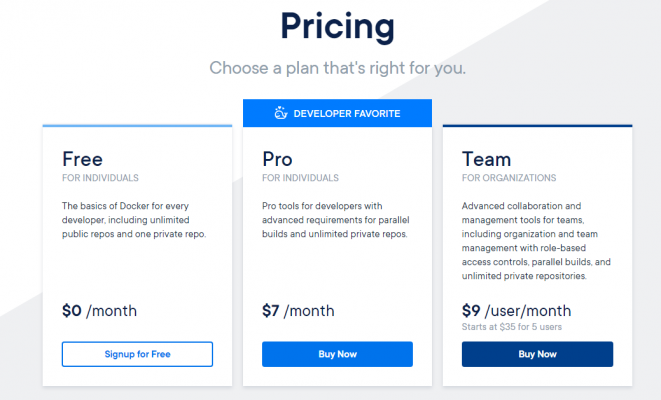
Docker Certified Associate Preparatory Guide
The preparation steps which are essential in order to successfully pass the Docker Certified Associate exam are:
Docker Official Website
Visiting the Docker official website is an imperative step while preparing for the exam like Docker Certified Associate Certification Exam. The official site offers a lot of reliable information and sources which is very helpful in preparing for the exam. The resources such as Docker Certified Associate (DCA) exam guide, sample papers, whitepapers, documentation, faqs, etc. The candidate can find all such important things on the official page.
Docker Training
The candidate can also opt for the Docker training programs. The Docker offers training programs on every exam. The training programs for a particular exam contain all information of the exam such as Docker Certified Associate exam syllabus, description, intended audience, delivery method, duration etc. The candidate should join a training program to gain knowledge and skills for Docker Certified Associate.
Practice Test
Practice tests are the one who ensures the candidate about their preparation. The Docker Certified Associate practice exam test will help the candidates to acknowledge their weak areas so that they can work on them. There are many Docker Certified Associate (DCA) practice tests available on the internet nowadays, so the candidate can choose which they want.
Join a Study Group
Joining a group study will also be beneficial for the candidate. It will encourage them to do more hard work. Also, studying in the group will help them to stay connected with the other people who are on the same pathway as them. Also, the discussion of such study groups will benefit the students in their exam.

